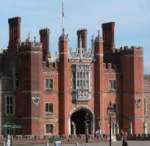PLANNING APPLICATION SUBMISSION - ENGLISH
HERITAGE
Dear Ms Biggs
20 December 2007
Notifications under Circular 01/2001 & GDPO 1995
HAMPTON COURT STATION AND THE JOLLY BOATMAN,
HAMPTON COURT WAY, EAST MOLESEY, ELMBRIDGE,
SURREY, KT8 0ST
Application No 2007/2970 and 2007/2971
Thank you for your letter of 16 November 2007
notifying English Heritage of the above
application. The proposals include a residential
and care home development, a new hotel, retail
and commercial development, associated ancillary
works and buildings, works to the transport
interchange and new areas of public open space.
English Heritage is particularly concerned at
the likely impact of this development on views
to and from Hampton Court Palace, its gardens
and park; the setting of the listed Hampton
Court Bridge, the banks of the River Thames and
the cumulative impact upon the established
character of East Molesey.
English Heritage has been closely involved in
pre application discussions surrounding this
site with all interested parties for much of the
past year. We are keen to encourage proposals
which will improve significantly the currently
extremely poor visitor experience of those
arriving at Hampton Court Station, the currently
semi derelict public realm between the Station,
the River Thames and Cigarette Island Park, the
setting of the grade II listed Hampton Court
Bridge and preserve the existing semi rural
nature of views from Hampton Court Palace across
the River to the Jolly Boatman site. Particular
attention during these discussions has been
given to the setting of the Palace, a scheduled
ancient monument and its grade I Registered
Gardens and Parkland, all of outstanding
national and international importance.
English Heritage considers that the above
objectives would best be achieved by an open,
landscaped public space with a number of modest
and carefully considered structures to provide
facilities for visitors to the area, not a
comprehensive and intensive urbanisation of the
site. We objected strongly to the earliest pre
application proposals for the site as likely to
have a major, adverse and detrimental impact
upon views to and from the Palace and the wider
riparian setting. As a result of discussions
held with Gladedale, Historic Royal Palaces and
the invaluable intermediary role of The Princes
Foundation the scheme as formally submitted is
likely to be less harmful in its impact than
initially feared, but English Heritage continues
to have significant and fundamental concerns
regarding a number of aspects of the scheme.
The hotel building proposed between the
Station and the River is in terms of its height,
scale, bulk and massing entirely inappropriate
to this highly sensitive location. The
introduction of such a substantially scaled
structure onto a site which is currently
undeveloped will have a major, adverse impact
upon the established character and appearance on
the setting of Cigarette Island Park, the
Station and Hampton Court Bridge and in cross
River views. This harm is particularly
exacerbated by the detailed design of the
building which is entirely inappropriate to the
conservation area and the wider setting in which
it sits.
The creation of a series of new public open
spaces, including access to the River Thames is
to be welcomed most warmly but the form and hard
and soft landscaping of these spaces must form
an appropriate response to the historic nature
of their immediate and wider setting. The
current proposals fail completely to rise to
this challenge. The stone terraces and steps
between the hotel and river are of a monumental
scale entirely alien to this stretch of the
Thames and are more reminiscent of Bazalgete's
work in Westminster than the domestic and
intimate nature of Hampton Court and the gentle
deference to its setting of Lutyens' Thames
bridge.
In a scheme of this complexity and
sensitivity there remain a considerable number
of matters which will require further
discussion. However, I suggest as a matter of
urgency a further meeting needs to be held,
aimed at finding a solution to the design and
appearance of the hotel and its setting all
interested parties can support and one which
will ensure that if the principle of such
development is to be accepted in this location
the outstanding significance of Hampton Court
Palace and its environs will be preserved and
protected.
Yours sincerely
T. D. Jones
Team Leader, Westminster and West London
E-mail: Tim.Jones@english-heritage.org.uk
HCRC and its supporters applaud the response
of English Heritage in its attempt to place
safeguards on the preservation of this
important, historically sensitive area.
